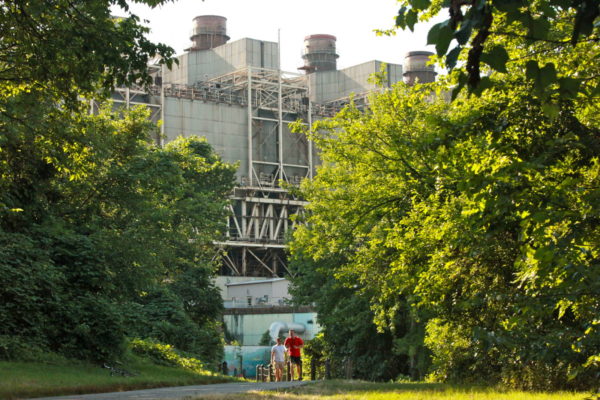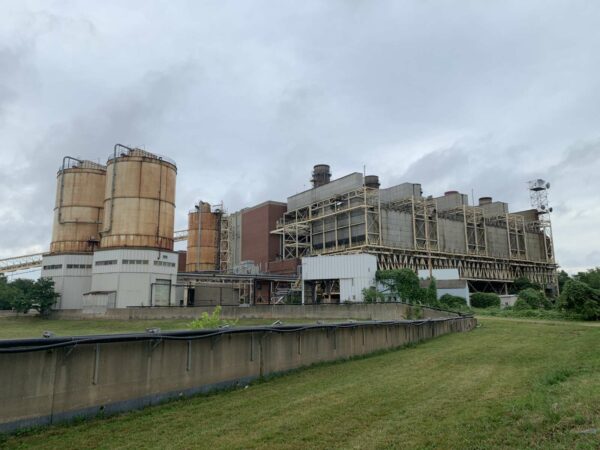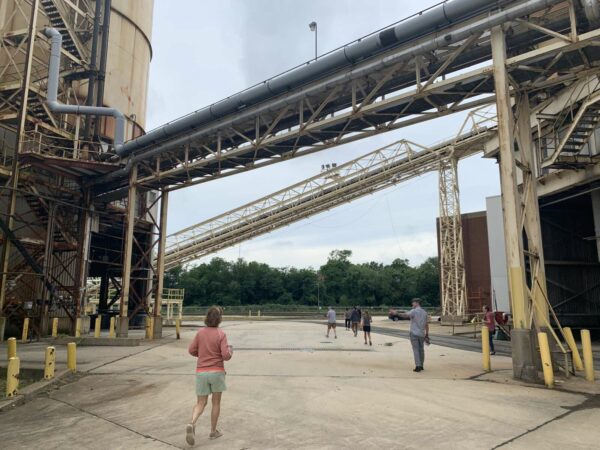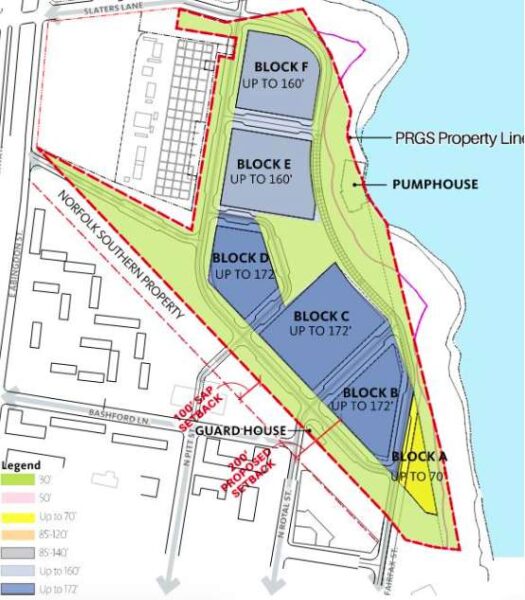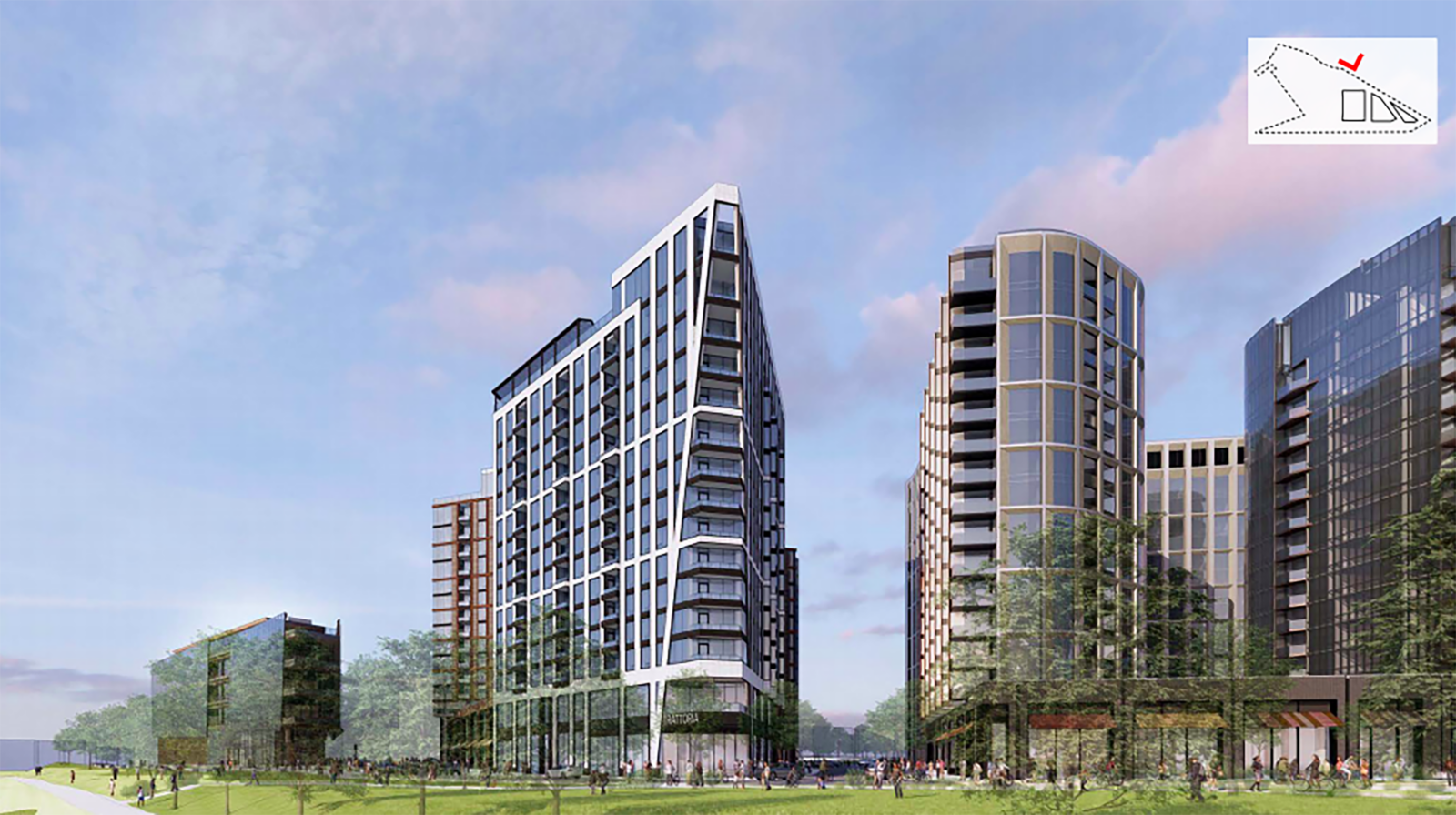
Hilco Redevelopment Partners said a new mixed-use development at the former GenOn Power Plant site takes inspiration from the Renaissance Revival-style Flatiron building in New York. Reception online was mixed.
The Flatiron, built at the start of the 20th century, is an iconic design at 175 Fifth Avenue. While the proposed developments at Block B have a similarly tall and narrow shape, the Alexandria building still has strong elements of the fast-casual architecture style dominating recent development around the region.
To the untrained eye, the triangular apex also draws some comparison to the Jawa sandcrawler.
What do you think? Do you see the Flatiron resemblance?
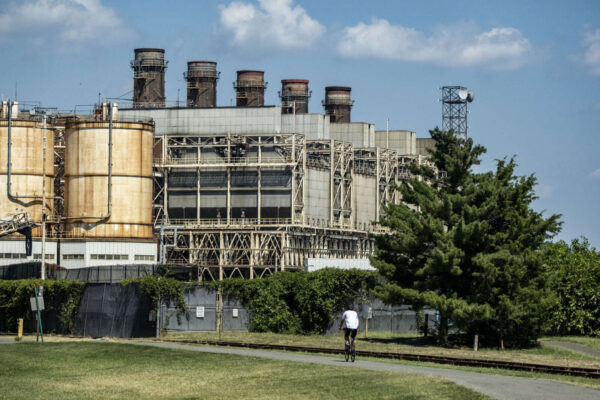
As developer Hilco Redevelopment Partners (HRP) heads into the ambitious redevelopment of the GenOn Power Plant, the developer laid out some of their plans for the complex process of breaking the site apart.
Representatives of the developer spoke last week to the Alexandria Local Emergency Planning Committee (LEPC) — full disclosure, this reporter is on the LEPC — about how the developers plans for abatement, remediation and deconstruction. The discussion was a follow-up to a previous LEPC meeting with Deputy Director for Infrastructure and Environmental Quality Bill Skrabak.
Mary Catherine Gibbs, land use counsel for HRP, said 2024 will likely be dominated by permit hearings for the project, with deconstruction and abatement starting in early 2025 — slightly later than the timeline laid out months ago.
The project is notable for the complexity of the environmental work that will go into making the former industrial plant a site safe for human habitation. Julianna Connolly is leading the remediation of the site and explained that remediation refers to anything on the ground level and below — like analyzing chemicals in the soil — while abatement refers to any of the environmental work above ground.
Connolly said there some of the sites of environmental contamination are already known.
“There’s an area on the site between the building and the river that had a known release from underground storage tanks,” Connolly said. “[They’re] still there, but closed.”
Connolly said the previous owner did remediation work to clean up the oil, but there’s still a residual impact on site that will need to be cleaned up.
Meanwhile, Connolly said her team has taken samples from across the site looking for more contamination — though the team hasn’t been able to sample under buildings yet. The early results, Connolly said, have been generally promising.
Metal content in the soil is generally below the standards set by the Virginia Department of Environmental Quality (Virginia DEQ). The main notes of concern in the soil samples are thallium, iron and manganese found above screening levels at a few locations. The screenings haven’t picked up polychlorinated biphenyls — a substance Connolly said is used to keep oil from lighting on fire — but she said it’s likely they’ll be found when her group checks closer to the transformers on-site.
Connolly said the next steps for her team are working through risk assessments for the site and developing a remediation plan.
“We already know we’re going to be working up near where the petroleum was, but we’re also identifying [other locations] on the site,” Connolly said. “We’re watching residual contamination very closely.”
For the above ground stuff, Nicholas Pullara, Vice President of development for HRP, said his team is combing through the site collecting regulated materials like asbestos, lightbulbs, electronic equipment and more.
“We’ve found asbestos, quite a bit of it, but it’s in good condition,” said Pullara. “We’ve found a slew of lightbulbs, things of that nature. We’re developing plans to remove all that prior to deconstruction.”
Pullara said HRP’s plan is to take the main power plant apart piece by piece rather than bringing it down all at once.
“We’re going to be sectioning out portions of the building and lowering them to ground piece by piece,” Pullara said. “We’re going after this in a very surgical [way] from a deconstruction perspective.”
For the eventual building deconstruction, rodent control will be put in place to keep a vermintide from flooding the nearby neighborhood. Pullara said HRP is looking for “non-poison solutions.”
For controlling dust from the site, Pullara said HRP will be using a lot of water.
“We’re going to use a lot of water,” Pullara said. “Asbestos needs to be wet when we put it in the bag… Water is key to dust mitigation. [We’ll have] high speed fans blowing a lot of water in a specific direction in a controlled manner. We want to focus the water where we’re creating that dust.”
Monitoring equipment will be set up for dust and vibrations from the site as well. Connolly said they know the air monitoring equipment works in in part because the smoke from the wildfires set off alarms at HRP’s project in Philadelphia.
Earlier discussion of removing pieces of the industrial plant from the site had indicated that barges might be an alternative to using trucks, but Pullara said the logistics at the site don’t work for removing debris into barges on the river.
(Updated at 4:10 p.m.) Alexandria is one step closer to the demolition of the NRG Potomac River Generating Station site in Old Town North.
On Saturday, City Council unanimously endorsed the plant owner’s Coordinated Sustainability Strategy, which outlines a plan to electrify the future mixed-use development slated to be built there.
Next month, City Council will conduct a public hearing on Hilco Redevelopment Partners’ (HRP) infrastructure development site plan, which details its proposal to build a mixed-use district. HRP plans on analyzing special use permits for the property between now and 2026.
Mayor Justin Wilson said that the project will be instructive for future projects.
“When’s the thing going to get knocked down?” Wilson joked to Hilco. “Today? Tomorrow?”
“If you could advance all of the approvals necessary, we’ll get started even faster,” replied Hilco’s attorney Mary Catherine Gibbs.
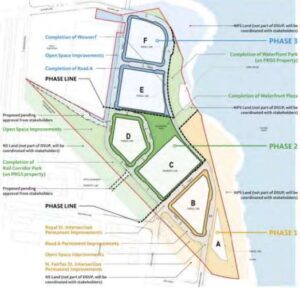
The plan to convert the property from district energy and combined heat and power systems to electric district energy and microgrid systems will mean all-electric building systems.
“Electrification of primary building systems ensures that there is a future pathway to carbon neutral operations while simultaneously delivering a high level of building performance and comfort,” HRP said.
HRP reported it will have to overcome a pandemic-induced severe supply chain backlog for critical equipment such as transformers, however.
HRP anticipates demolition could start next year. The former power plant first opened in 1949, shut down in 2012, and was acquired by HRP in 2020.
The site needs extensive remediation after leaky storage tanks bled pollutants into the soil.
The coal-fired power plant also severely polluted the air, according to HRP:
The facility emitted 3.15 million metric tons of CO2e annually, among other contaminants, or nearly 200 million metric tons of CO2e over the course of its operation. Concerned citizens hired scientists to study the power plant’s pollution, which triggered local and state investigations into the site. Air quality studies found that the plant violated national ambient air quality standards for sulfur dioxide, particulates, and nitrogen oxide.
The eventual redevelopment will occur in three phases, each consisting of two blocks, beginning with blocks “A” and “B” at the southernmost portion of the property. HRP proposes 80% of the buildings in blocks A, B and C to be residential development with 20% dedicated to commercial spaces
The project includes 14.2 acres of new or improved open space and people can share their vision for the open spaces in a survey that is active until May 31.
“At its core, the project is the removal and remediation of a power plant,” Dustin Smith, the city’s green building manager, told Council. “Following a decade’s long community process to achieve this, the redevelopment will bring with it stormwater and transportation infrastructure improvements and additional areas of open space to the Old Town North neighborhood.”
In its sustainability strategy documents, HRP said that the development will be transformed into a “vibrant, urban, mixed-use community that will include office, residential, arts, hotel, entertainment, retail, and restaurant use.”
“The property will be reconnected to the surrounding Old Town North neighborhood through the extension of the existing street network and the seamless integration of new publicly accessible parks with existing and future public open space,” the developer wrote.
“The site will be accessible through public transportation, the pedestrian and bicycle network, and will engage the adjoining uses and buildings, offering Alexandria the ability to showcase forward thinking urban and sustainable planning and development,” it continued.
Images via City of Alexandria
As plans for what will replace the Potomac River Generating Station in Old Town North gradually take shape, the city is still working through the specifics of how exactly to tear down the building.
Deputy Director for Infrastructure and Environmental Quality Bill Skrabak said in a presentation yesterday to the Alexandria Local Emergency Planning Committee — full disclosure, this reporter is a member of that committee — that rather than one big demolition the building will most likely be taken apart piece by piece.
“They’re going to be cutting up the big metal pieces with cranes and demolishing it, hauling it out on trucks and salvaging as much metal as they can,” Skrabak said. “Once the buildings get down to the ground, that’s when they would shift to remediation and soils.”
Skrabak also said there’s still work to be done to determine just how contaminated the soil at the site is. There are two large underground oil tanks at the property, at least one of which leaked around 2013. A remediation project was ongoing from 2016-2019 for that leak, but that remediation was to the standard of an industrial site, not a residential one like what’s proposed.
Beyond just those two tanks, though, Skrabak said there are other smaller tanks buried around the site that could contain chemicals.
One concern raised in the public comment at the meeting by nearby residents is that it’s still unclear just how contaminated the soil is at the site.
“We don’t have a gosh darn idea what’s underneath that building,” One resident said. “All the soil sampling and water sampling has been done in relatively benign areas but we have no clue what’s underneath that building. But here we are looking at how Hilco is going to approach this with what seems to be a pretty risk-tolerant position.”
But Skrabak said there’s a logic to demolishing the building before doing extensive testing on the soil.
“They will be doing an abatement to remove the contaminants before they demolish the buildings but you can’t do the remediation until the buildings are gone,” Skrabak said. “They’ll have to do additional samples once the building is gone.”
Skrabak said the soil will be sealed or covered when it’s transported away from the site in trucks.
“There are state requirements during construction for that material; they have to do the best job they can to reduce the amount of pollution as best they can,” Skrabak said. “There are certain structures they have to have, like the installation of a silt fence. What we try to do, when they’re excavating contaminated soils… we want them to get it in a container and into a truck and not have a big stockpile of contaminated soil sitting at the site for weeks.”
While Skrabak also said there’s no risk of runoff flowing back into neighborhoods, the same can’t be said for contaminants making their way into the Potomac River during demolition and construction. As locals have discovered in recent years, heavy rainfall can cause overflow to many stormwater management systems.
“Depending upon the level of issues, typically they have a sediment basin where they try to filter as much of that and let it settle before it gets discharged,” Skrabak said. “I do want to forewarn people, it’s not possible to have that level of disturbance and not have some dirt and mud. They’ll have a basin and settling tanks before it gets discharged, but if you have a large event it bypasses the filter.”
That demolition is still at least a year way. Alexandria Living Magazine reported in November that Hilco Redevelopment Partners confirmed the demolition of the power plant won’t start until mid-2024 at the earliest.
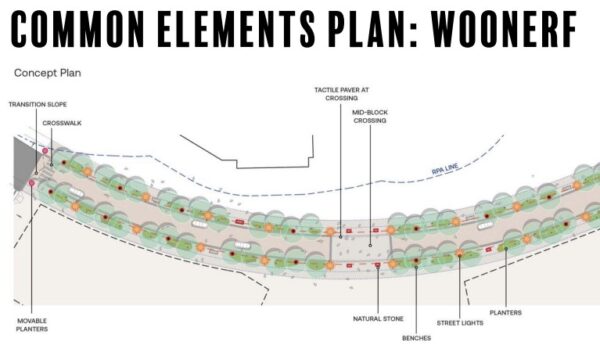
(Updated 6:17 p.m.) Representatives from Hilco Redevelopment Partners (HRP) recently opened up about some of the behind-the-scenes discussions on whether or not to make the central street in Old Town North’s power plant redevelopment project pedestrian-only.
The redevelopment of the GenOn power plant in Old Town North is one of the biggest projects on the city’s horizon, and the centerpiece of that project will be a pedestrian-focused boulevard called a ‘woonerf‘ — a Dutch design concept that prioritizes pedestrian and bicycle traffic.
Simon Beer, with landscape architect OJB, said that the idea is to maintain a pedestrian flow around the project, connecting both to the Potomac River and Old Town North.
But while the city has had some success with pedestrian-only zones in Old Town, the woonerf will not be exclusively for pedestrians and cyclists. Though HRP representatives said the street will be designed to slow traffic, vehicles will still be allowed to travel on the street except when its closed for special occasions.
At a meeting of the Urban Design Advisory Committee Serving Old Town North last week, committee members shared concerns that permitting vehicle traffic means the streetscape won’t truly be pedestrian focused.
“Was it ever explored to have this as a purely pedestrian street?” asked committee member Zaira Suarez. “As long as there are vehicles, there’s never really complete safety for pedestrians.”
Suarez expressed concerns that space that could otherwise be used for community amenities would become on-street parking.
“It becomes a parking space when it could really be such a huge amenity to pedestrians,” Suarez said, “not only residents but people coming in from the park or on bicycles from the trails. Is there something stopping this from becoming fully pedestrian?”
Beer said pedestrian-only was considered during development.
“It was absolutely something that was explored,” Beer said, “In conversations with city and traffic planning, there was a feeling that the ability for traffic to be able to flow along the waterfront was important, not only for emergency access but for general day to day use. However, we think that this can be a really special place.”
Beer said the street is designed to be shut down for weekends or special events.
“Having the ability to shut it down, placing planters on either end, we have the capacity… to shut it down for a weekend for a large event, we have the capacity to do that with the way that this is designed,” Beer said. “It really has the flexibility for a truly pedestrian experience, but designing in that flexibility to still maintain traffic flow.”
Attorney Mary Catherine Gibbs said the street is built with a public access easement and can’t be permanently shut down without city approval.
“The city won’t allow it,” said Gibbs. “The city has asked that it be a public access easement, so there will be limits on our ability to completely shut it down permanently.”
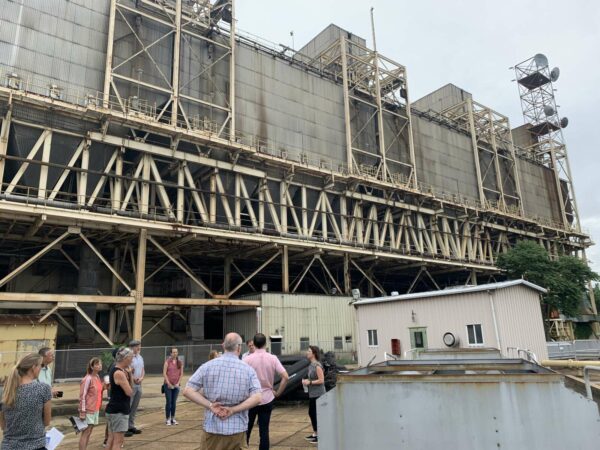
Beyond the usual mixed-use development topics planned for the immense power plant in Old Town North, there are two other critical issues up for review at a meeting later this month: how the development will handle the rampant contamination at the site and a look at plans for new open space.
Hilco Redevelopment Partners (HRP) have scheduled a community meeting to discuss the remediation and open space plans on Monday, Jan. 30, at 6:30 p.m. The developer will stream the meeting online, but attendees can join in person at ALX Community (201 N Union Street).
The NRG Potomac River Generating Station — also called by its former name, the GenOn power plant — shut down in 2012, but the site will require extensive remediation efforts after leaky storage tanks bled pollutants into the soil.
Preliminary plans identify areas where chemicals and oil were released on site, and notably the entire southern portion of the property was used as coal and coal ash storage, Washington Business Journal reported. While initial plans said demolition could start this year, that was recently pushed back to mid-2024.
The current plan or the redevelopment also includes 14.2 acres of new or improved open space, with the potential to improve parts of the Mount Vernon Trail adjacent to the site if Hilco can find a way to work with the National Park Service.
Those planning to attend the upcoming meeting can register online.
(Updated 10:25 p.m. on 11/22/22) The roadways in Old Town North are set to get an upgrade, thanks to the massive GenOn Power Plant redevelopment.
The 18-acre power plant site has no internal transportation infrastructure, and on Wednesday night (Nov. 8) Hilco Redevelopment Partners revealed its concept designs for the street network.
Over the next decade, the development will convert the power plant site into a new mixed-use neighborhood with residential units on the upper floors, and commercial and artistic spaces on the ground floors.
“The site has no internal infrastructure today, so we’ll be investing a substantial amount to create new roads, sidewalks, bicycle accommodations, and the public walk route, as well as utilities,” said Michelle Chang, HRP’s vice president of mixed-use development, in a virtual meeting on Wednesday. “All of these will promote walkability, provide new bus stops and decrease reliance on personal vehicles. Additionally, HRP will make offsite improvements along Slater’s lane and intersections with the George Washington Memorial Parkway to improve vehicular bicycle and pedestrian connections. All told, we estimate these will (cost) $177 million.”
Plans call for a complex network of public and private streets, all of which will be publicly accessible. The roadway is designed to minimize cut-through traffic with a main public road, or spine street, going straight through the property.
HRP’s development special use permit concept submission will have to undergo a community review process next year before going to the city for final approval.
More than 14 acres of the site is devoted to open space, and the property even incorporates Dutch design with the inclusion of a woonerf, a “people-focused” street facing the waterfront that will allow for easy closure for events.
Demolition for the site is slated to begin next year on the 18-acre site in Old Town North, and construction is expected to take between 18 and 31 months. In fact, the entire development may take 10 years to complete.
HRP is also proposing these roadway changes:
Bashford Lane at the George Washington Memorial Parkway
- Pedestrian crossings need improvement
- Traffic signals currently prioritize north-south traffic, which will have to be balanced for east-west movements for all modes of transportation
Slaters Lane at the George Washington Memorial Parkway
- Balance signal operations for east-west traffic
- Improve pedestrian crossings
- Extend bike facilities through the intersection with GWMP and connect to the Mount Vernon Trail
Earlier this week, Alexandria’s City Council approved two major steps forward for plans to redevelop an abandoned power plant at the north end of Old Town’s waterfront.
The project faced some pushback from tenants and worker unions and the Metropolitan Washington Airports Authority (MWAA), but ultimately the city voted to approve a master plan amendment for the site and a coordinated development district (CDD) to encompass the project. The master plan amendment was unanimously approved, but the CDD was approved in a 6-1 vote with Council Member Alyia Gaskins voting against it.
The plan is to convert the site into a new mixed-use neighborhood with commercial and artistic spaces on the ground floors and residential units above. The project plans also include plans to prioritize pedestrian and cyclist traffic through the site.
Local workers said they were concerned the project would create more low-paying jobs that wouldn’t pay enough for the workers to live in Alexandria, while MWAA expressed concerns that the heights allowed in the redevelopment plans could interfere with traffic to and from National Airport. The MWAA later clarified that while those concerns still exist, they didn’t believe the project needed to be deferred.
Gaskins said at the meeting that her main concerns were around the public-private partnership that much of the site’s affordable housing hinges on. If the partnership falls through later in development, the city could be left with less housing than currently planned.
For others on the City Council, the potential benefits from the development outweighed that risk. Mayor Justin Wilson said the main benefit of the redevelopment is the extensive environmental rehabilitation required for the former industrial site.
Even after pushback by groups ranging from tenants and worker unions to the Metropolitan Washington Airports Authority (MWAA), Alexandria’s City Council approved a major step for the GenOn Power Plant redevelopment’s Coordinated Development District (CDD) in a 6-1 vote at a meeting last night (Tuesday).
As with earlier contentious developments, City Council members said they acknowledged concerns about the project, but Mayor Justin Wilson said the prospect of finally cleaning up the power plant site eclipsed those issues.
“This is a really big deal today and this is a long time coming,” Wilson said. “If you walked down our waterfront in the 90s and started in the south and walked north, you’d walk through a series of industrial sites and this is the last one that we are talking about redevelopment of.”
Wilson said of all of the industrial redevelopment along the waterfront, redevelopment of the power plant is likely the most challenging and the environmental rehabilitation of the site goes a long way to overriding other concerns.
“The most significant public amenity we are talking about in this is the clean-up of this site,” Wilson said. “And if you don’t believe me go right now to the real estate assessment page. This site is 18 acres and is assessed at $10 million. Eighteen acres in the city of Alexandria would cost you hundreds of millions of dollars, but the reason it doesn’t is because of the dramatic environmental cleanup required on this site.”
While the project had its supporters in the public comment section, several representatives from local unions also showed up to voice concerns that the new development would only generate low-paying jobs. Another concern is that the planned public-private partnership to create affordable housing at the site was built on a shaky foundation, with the possibility of the partnership falling through for one reason or another and the city not getting the full amount of affordable housing units as currently planned. City Council member John Chapman agreed that “it doesn’t excite me that we have the possibility of losing this and only being stuck with a certain amount of housing.”
“I’m excited to see us get to this point,” Wilson said. “I think this is a transformational project. Is this what everyone wants for the site? Of course not. But I think we have a tendency in this city to love these projects to death and I don’t want to see that happen to this one because I think this is so important. 15% of nothing is still nothing. We’ve learned that on projects around the city before.”
The vote on the project was broken up into a motion to approve a master plan amendment for the site and the CDD concept plan. The master plan amendment was approved unanimously, but Council Member Alyia Gaskins was the lone vote against the CDD concept plan.
“I think this is a big deal,” Gaskins said. “I think this will be transformational… [but] right now we are not using this to its highest and best potential. I also think we have said over and over that this is a place where we are reserving the opportunity to do really creative and innovative things. For me, one of the things I think is the most innovative is the PPP and the opportunities for affordable housing. At the same time, that’s the most shaky part.”
Gaskins said there are too many unknown factors, particularly at a state level, behind the public-private partnership plans to fully trust for a development of this scale.
“There are things we can’t predict,” Gaskins said. “While I love this project, I love our people more. It’s a good project and we need to keep this moving forward, but I don’t feel that we are fully living up to the promise and the vision outlined in the small area plan around housing.”
Updated 4:30 p.m. — A spokesperson representing Hilco Redevelopment Partners shared an email with WMWAA indicating that the Airports Authority “is comfortable that the City of Alexandria does not need to ‘defer’ decisions slated for this Application today; instead, the Authority welcomes the City’s expressed commitment in its decision to require increased coordination between MWAA and the City as this Application moves forward.”
The spokesperson also said that because no specific building heights are proposed, the building heights cannot be considered a threat to DCA safety
The CDD process is strictly to discuss zoning and master planning- there are no specific buildings proposed at this time. Given there are no buildings being discussed, and thus no proposed building heights, we do not believe it is possible for there to be a threat to DCA safety. We would like to request the article be retitled accordingly, as we find the current title to be misleading. Please note: when applications are submitted for DSUP discussions, building heights will be included. At that point, MWAA would weigh in on building height and its potential effects.
Earlier: In a letter to Alexandria’s City Council, the Metropolitan Washington Airports Authority (MWAA) has shared concerns that the proposed redevelopment of the GenOn Power Plant could pose a hazard to air traffic at the nearby National Airport.
Alexandria City Council will consider a proposal tonight (July 5) by Hilco Redevelopment Partners to transform the shuttered GenOn Power Plant in Old Town North into a six block, 2.5 million square-foot mixed use development. The property is 1.2 miles (6,336 feet) from DCA, and the proposal would allow the construction of buildings up to 197 feet above ground level.
The MWAA letter says the structure heights proposed for Blocks C through F of the development “would likely introduce penetrations to Critical Air Navigation Surfaces and would likely impact existing and future air navigation at Reagan National.”
MWAA’s analysis said the approaches to and from the main runway are already constrained by limitations caused by tall structures in Rosslyn, Crystal City and Alexandria, as well as the prohibited airspace east of the Potomac river over large sections of D.C., according to MWAA Planner Gregg M. Wollard.
The letter says a preliminary analysis determined the structure heights should be lowered by approximately 19 feet to ensure no impacts on air travel with the tallest of those blocks coming in at 186 feet and the tallest in the total development as 197 feet. MWAA is also requesting that approval be deferred until the applicant, Hilco Redevelopment Partners, files a permit with the Federal Aviation Administration.
“It is recommended that the City of Alexandria defer its full final approval until a Federal Aviation Administration (FAA) 7460 is filed by the applicant, in accordance with FAA requirements well in advance of construction, and a formal determination is made by FAA for all proposed structures,” Wollard wrote. “In addition, the proposed site will be exposed to loud and frequent noise from low-flying arriving and departing aircraft because of its proximity to DCA’ s existing Runway 1/19.”
The MWAA letter said that the buildings penetrating the airspace would have a negative impact on airport operations.
“If buildings penetrate these surfaces, they can have an adverse impact on airport operations,” the letter said, “such as restricting the type of aircraft that can operate, destinations that can be served, and impose aircraft weight limitations (i.e., reduced passengers, cargo, and fuel).”
The letter comes after tenants and worker groups in the area also shared concerns about the sweeping redevelopment plans for the site.
James Cullum contributed to this story


